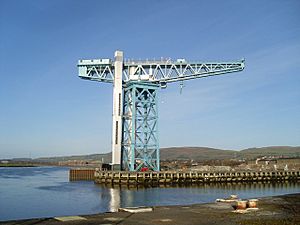Titan Clydebank facts for kids
The Titan Crane is a huge, tall crane in Clydebank, Scotland. It stands about 46 meters (150 feet) high. This special crane was built to lift very heavy parts, like engines and boilers, into large ships. These ships included battleships and big ocean liners. The Titan Crane was the first of its kind in the world to be powered by electricity. When it was finished, it was also the biggest crane of its type.
This amazing crane helped build some of the largest ships of the 1900s. These included famous ships like the Queen Mary 2 and the Queen Elizabeth 2. The Titan Crane is now a protected historical building. It was fixed up in 2007 and is now a popular place for visitors. You can even see it on the Scottish £5 note!
Contents
History of the Titan Crane
The shipyard in Clydebank started in 1871. A company called John Brown & Company bought the yard in 1899. In 1905, they ordered the Titan Crane from Sir William Arrol & Co. The crane was finished two years later, in 1907.
A Scottish engineer named Adam Hunter designed the crane. He had also worked on the famous Forth Bridge. Most of the crane's machinery was made and put in by Stothert & Pitt. This included the electric motors.
What the Crane Did
The shipyard used the Titan Crane to "fit out" new ships. This means they would lift huge engines and boilers into the ships' hulls. The crane's great lifting power helped the shipyard build very large vessels. Its location near the River Clyde also made it perfect for this work.
When it was tested in 1907, the Titan Crane could lift 160 tons. This made it the biggest crane of its kind. In 1938, its lifting power was increased to 203 tons. This was needed to install the heavy gun turrets on new warships, like the Duke of York.
Surviving the War
During World War II, Clydebank was heavily bombed in March 1941. This event is known as the Clydebank Blitz. Many buildings were destroyed, and many people were hurt or lost their homes. However, the Titan Crane was not damaged during these attacks. It stood strong while much of the town around it was ruined.
Changes at the Shipyard
In 1968, the shipyard joined with four others to form Upper Clyde Shipbuilders. This was an effort to make the shipyards more competitive. However, funding problems led to the closure of John Brown's yard.
Later, the yard was bought by different companies. First, Marathon Manufacturing Company used it to build oil rigs. Then, a French company, Union Industrielle et d’Entreprise (UiE), took over. UiE closed the yard in 2001. After that, the area was planned for new development.
Famous Ships Built Here
The Titan Crane helped build many famous ships. These include:
- HMS Hood
- Queen Mary
- Queen Elizabeth
- Queen Elizabeth 2
- The Royal Yacht Britannia
Bringing the Crane Back to Life
The crane was not used much after the 1980s. Over time, it became damaged by vandals and rust. In 1988, it was officially recognized as an important historical building.
In 2005, a group called Clydebank Re-Built started a big project to fix the crane. They spent about £3.75 million on the restoration. The crane opened to the public in August 2007. Workers cleaned off old paint and rust. They also made repairs and repainted the crane.
Now, visitors can take a lift up to the top of the crane. There is a viewing platform where you can see amazing views. Safety netting was added around the viewing area. Floodlights were also installed to light up the crane at night. In 2015, a bungee jump was even added for thrill-seekers!
How the Titan Crane Works
The Titan Crane was very advanced for its time. It used a heavy counterweight to balance the loads it lifted. All its lifting parts were powered by electricity. This made it much faster and easier to control than older cranes that used steam.
For smaller items, the crane had a special 30-ton hoist. This was used when the full 150-ton lifting power was not needed. Very large loads were not lifted every day.
Crane's Size and Structure
The Titan Crane is about 49 meters (160 feet) tall. It weighs around 800 tons. Its base sits on four concrete pillars that go 23 meters (75 feet) deep into the ground. The crane's arms, called cantilevers, are different lengths. One arm is 45.7 meters (150 feet) long, and the other is 27.4 meters (90 feet) long. The main tower is 12 meters (39 feet) square. It stands very close to the edge of the dock.
After some other large cranes were removed, there are now four giant cantilever cranes left on the River Clyde. These are the Titan Crane, the Finnieston Crane in Stobcross, the Barclay Curle Crane in Scotstoun, and the James Watt Dock Crane in Greenock. Fewer than 60 of these huge cranes were built worldwide. Six of them were on the Clyde. As of May 2011, only 11 were believed to still exist, with four of those being on the Clyde.
Awards and Recognition
The Titan Crane has received several important awards. In 2012, the Institution of Mechanical Engineers gave it the Engineering Heritage Award. They called it "a magnificent example of mechanical engineering."
In 2013, the American Society of Civil Engineers and the American Society of Mechanical Engineers named it an International Historic Civil and Mechanical Engineering Landmark. This was the fifth time a Scottish structure received such an award.
The crane's restoration also won awards. It received the Chicago Athenaeum Award for Architecture in 2008. The Civic Trust also recognized it in 2009.
Images for kids
-
The ticket office (also known as the Pursers Office) and information centre at the Titan Crane, featuring a silhouette of the RMS Queen Mary.







